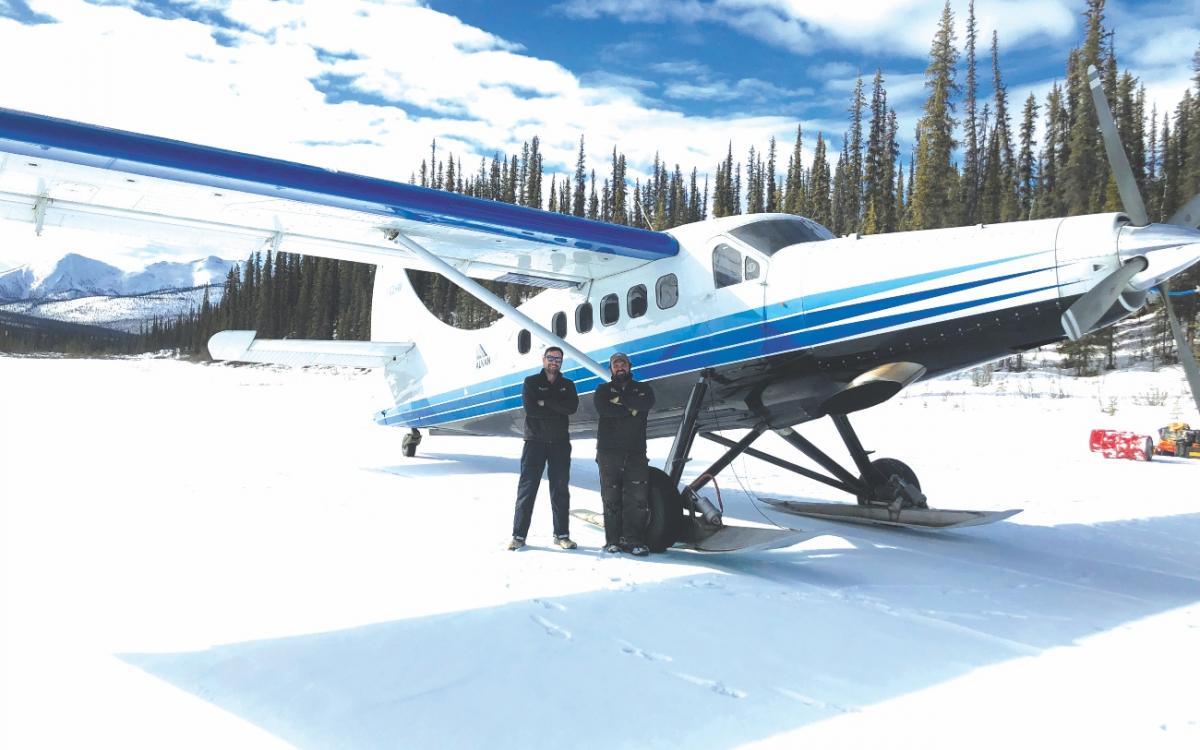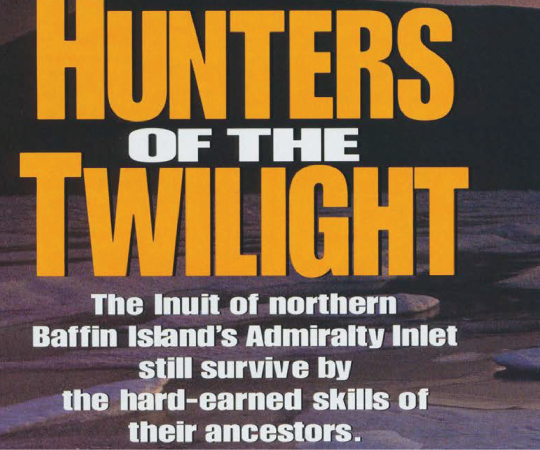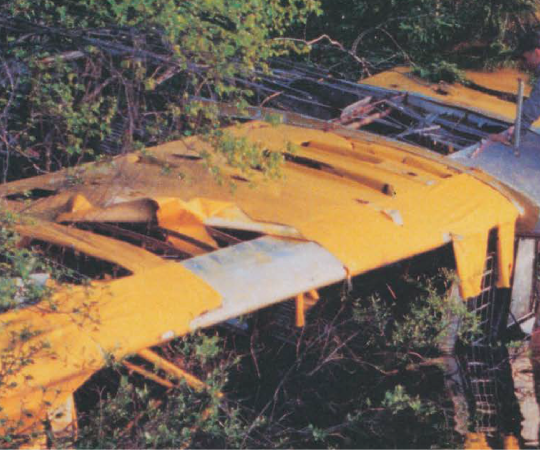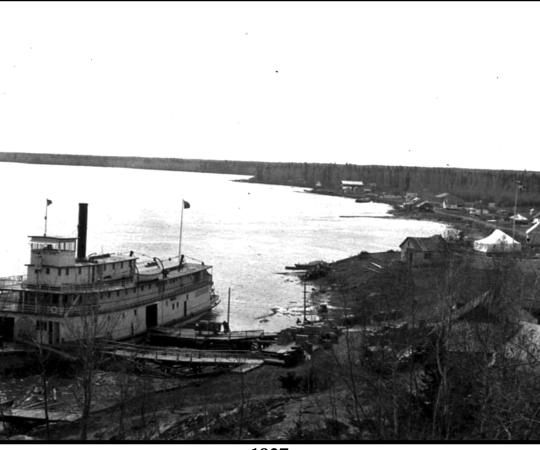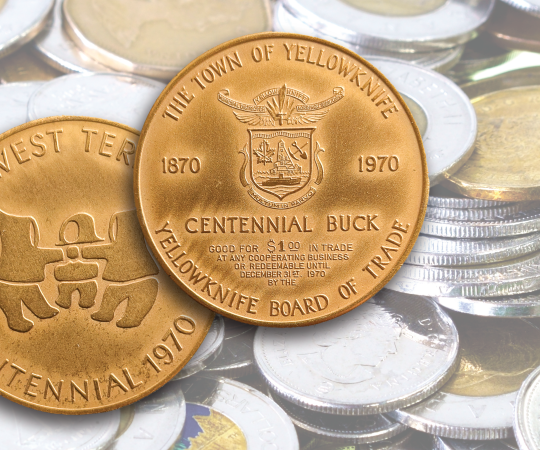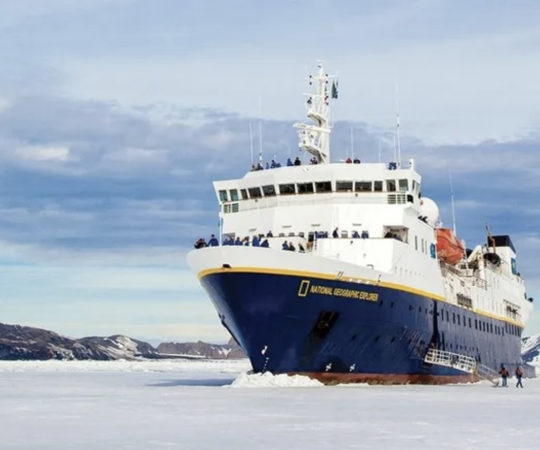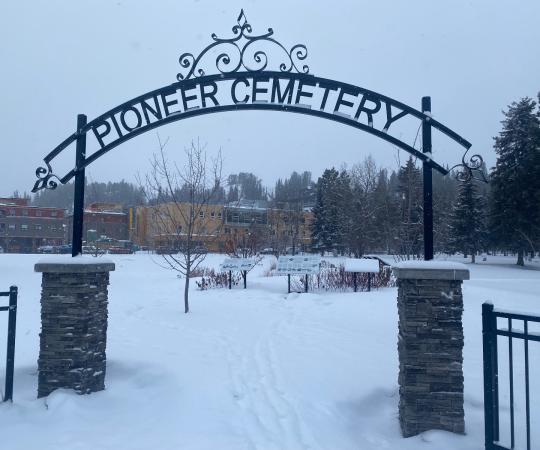Jeff Faulkner climbs into the cockpit of his De Havilland single-engine Otter. He lays out his map, runs through his check list and scans the grid of meters on the instrument panel of his plane. Then he fiddles with some buttons and knobs and the propeller starts to spin and he taxis down the runway until the nose of the plane lifts up and soars into the air. Faulkner’s heart skips a beat, knowing that even after 15 years of flying, the feeling of taking off never gets old.
“It’s my sandbox. I’m in control of what I do as soon as I close that door,” says Faulkner, who flies for Yukon-based Alkan Air. “I like flying over the Yukon scenery. I like going to remote places.”
Built in 1953, the single-engine Otter he flies is nothing fancy and it’s much older than him. The seats are rigid, there’s no auto pilot and it’s certainly not made with any of the comforts of a newer airplane. But that’s exactly what Faulkner loves the most about it. Each flight is like a trip back in time.
“I feel like I’ve had the chance to experience the glory days of bush flying when the really old airplanes had no GPS,” he says. “All that was way before my time, but I like to think I got in on some of the better flying that was done and I’m pretty happy I made my career flying in the Canadian north.”
Anyone involved in aviation up here can tell you about some of the old planes that soared across the territories. Planes like the Otter and Beaver are still going strong but getting them up in the air and on par with modern aircraft is no easy feat. It requires hours of maintenance, plenty of money and sometimes arduous searches for the right replacement parts. So why is it that so many pilots insist on revamping old aircraft, instead of adapting to new planes? The answer is multi-fold, but it comes down to necessity and nostalgia.

In 1920, three aviators geared up for the trip of a lifetime. Starting in Mineola, New York, the crew flew nearly 3,000 miles in US army DH-4 biplanes and landed on a Whitehorse golf course-turned air strip. They touched down to a crowd of people who likely had never seen a car before, let alone a flying body of machinery. Those pilots made history that day and proved long distance air travel was possible.
That trip opened doors for other pilots who wanted to explore the great North and in February of 1921, two chartered planes flew from Edmonton to the NWT, fighting their way through Arctic blizzards. Their landing was not so smooth, as one plane’s propeller snapped off upon landing in Fort Simpson and a mechanic had to glue scrap wood together to make a new one. Tales of adventure have only grown since. Famed pilot C.H. “Punch” Dickins delivered the territory’s first airmail to the NWT in 1929 and even Charles Lindbergh and his co-pilot and wife Anne Lindbergh touched down here, when their plane stopped in Baker Lake and Aklavik.
These journeys were ones many pilots can’t imagine today. Crews had to don wind-proof suits, lambskin-lined helmets and fur-trimmed goggles, among several other layers, to push through icy winds in an open cockpit aircraft.
“In the North, pilots and planes were breaking new ground by taking the place of dog teams and big canoes,” says Warren Wright, founder of Norman Wells-based North-Wright Airways. “Land and water travel meant going into the North the long way around …..and then it was being done by aircraft in less than half the time or a quarter of the time. Without airplanes the North wouldn’t be as it is these days. It’s thanks to the pilots who endured the cold and the long hours of flying and kept going.”
Runways back in the 1920s and ’30s were no more than stretched out plots of land and open fields of grass. It didn’t matter what it looked like—as long as there was a clear stretch of about 1,400 feet ahead of them. These days, modern planes need a solid paved runway that stretches out to at least 2,000 feet to safely set their wheels down.
“You need those big thick wings and big flaps [you see in older planes] to get that short take-off and landing,” Faulkner explains. “You pay the penalty in speed though, so once you’re off the ground you can’t go as fast as in something sleeker like a jet, but you can get off the ground on [a much shorter] runway.”
Canadian North is facing that dilemma of old runways versus new planes, as two of their aircraft servicing Cambridge Bay and Kugluktuk are on their way to retirement. The two Boeing 737-200s—manufactured in the 1970s—are set to go out of service by next year. But most new planes can’t fill their shoes because they can’t handle the short gravel runways.
Enter the ATR42-500 turboprop aircraft, made in 1995. Canadian North acquired it to service the Kitikmeot region and although it will add 20 minutes to flight times, it can at least handle the shorter, gravel landings.
When it comes to bush flying, there are even fewer new aircraft that can do the job like the old De Havillands can. “They were purpose-built to be easy to operate in remote locations where you don’t have a lot of help,” says Faulkner, a self-proclaimed “De Havilland guy.”
The closest replacement is the Cessna Caravan, which was first produced in 1982, a youngster among northern planes. Those models are what Faulkner describes as a jack-of-all-trades. The turboprop single-engine craft is most popular as a mail carrier with FedEx (which owns 260 Caravans), while also acting as a freight hauler, a carryall water taxi and a private airplane.
So couldn’t most people just switch over to Caravans? As Joe McBryan, aka Buffalo Joe, might tell you: the old airplanes are not done flying yet.
Buffalo Airways has a fleet of planes spanning 80 years, but has become best known for its World War Two era planes. That’s especially so after the reality TV series Ice Pilots premiered in 2009. It follows McBryan and his crew, as they deliver goods across the territory in vintage aircraft. After the show’s ending in 2014, son Mikey McBryan continued to post videos through his YouTube show, Plane Savers. Watched by more than 3 million viewers, the online videos document the process of rebuilding a Douglas DC-3 plane, which Mikey bought through eBay. That very airplane was made in 1944 and dropped 17 paratroopers behind German lines in Normandy. After the war, it was remodeled as a civilian plane and flew with a few airlines until the 1980s. Then it switched hands once more–to Buffalo.
On June 6 2019, just in time for the 75-year anniversary of D-Day, the DC-3 flew over a crowd of nearly 6,000 watching in Montreal. It was the first flight that DC-3 had taken in nearly 30 years.
The McBryans declined to comment for this article, but former aviator Yvonne Quick points to the DC-3’s success. She mentions there are currently 50 DC-3s registered in Canada and another 211 registered in South America.
“It must be a good plane if there’s still 261 of them flying somewhere in the world,” she says.
Buffalo isn’t alone when it comes to flying vintage aircraft.
Just look to Norman Wells, and there’s a good chance you’ll see a Cessna or Beechcraft flying overhead with North-Wright Airways’ orange and white logo emblazoned on its rudder. The family-run business has been around since 1986 where they move people, mail and freight across eight NWT communities. Their fleet ranges from modern Caravans to 1960s models. But as Wright says, just because they’re older, doesn’t mean they work any differently than modern machinery.
“The age of the airplane doesn’t mean that much,” says Wright. “There’s nothing to replace [these old aircraft] and they’re better maintained now than they have ever been.”
That’s a message both Wright as well as other pilots want to emphasize. While the public perception may be that older aircraft won’t hold up to newer models, the amount of work that goes into them ensures quite the opposite is true.
Retro aircraft must go through regular inspections and yearly maintenance. Aviators keep track of the work that has been done through a logbook, while the Transport Canada Civil Aviation (TCCA) keeps records of each plane, propeller and engine. And before replacing parts of an aircraft, each piece must first be approved by the TCCA to ensure the parts meet safety mandates.
“These planes are better maintained now than when they first came off the line because of all the rules in place,” Wright says.
That rings true for Wright’s private projects as well. Although retired from North-Wright, you can often find him switching between three hangars across Norman Wells, where the pieces of a 1941 Stinson Gullwing are stored. Wright flew that plane north from Ontario 45 years ago, but it’s only been in the last year that Wright began to take the craft apart and rebuild it.
Many of the original parts have eroded over time, so he’s replacing them with pieces from a Fairchild. He’s also redoing the fabric body—a pure relic of the past, as most fabric on planes these days has been replaced with aluminum skins.
“It’s hard to get people to do the fabric work, but it’s familiar to me,” he says.
Wright is waiting on approval by the Federal Aviation Administration (the US counterpart to TCCA as his plane is American), but once the paperwork goes through, he hopes to have the project up and running by next summer. Given the plane’s history as a former US army plane during the Second World War, reviving it is Wright’s way of honouring the past.
“It’s one of those bucket list items to get one of those old planes back in the sky,” he says. “There’s a lot of pilots who would like to see that [antique] stuff back in the air. We all do.”
But the question is: how long can we keep old airplanes going?
“That’s a million-dollar question,” Faulkner says. He explains with each year, they require more inspections and constant maintenance.
“If you kept doing maintenance forever, then the airplane would run forever but at some point, maintenance requirements are just going to become too onerous and the airplanes will cease to be economical and unfortunately will end up in museums.”
That’s how the Fairchild and WACO planes have come to land at the Yukon Transportation Museum. The former belonged to Northern Airways—the Yukon’s first reliable air service in the 1930s and ’40s until it ceased operations in 1950. The two planes had been left untouched for decades, with one sitting unmoved at the end of a runway and another in the middle of a farmer’s field in BC. Rather than letting them continue to deteriorate, a team is working on bringing their appearances back to their former glory, so the public can learn about the connection each one had to the Yukon.
Mines and busier hubs are aware that the old birds won’t last forever and they’re doing what they can to remedy that by building longer runways for jets to eventually take over. Plus, the newer planes are simply more convenient to run.
“Airplanes in use today are faster and of course with all the electronics and the navigational aids, it means a pilot doesn’t need to know where the hell he is because it pops up on his GPS,” says Quick.
But for many pilots up here, that takes the fun out of flying. It’s climbing into the worn seats of an old plane and manually going through the motions that’s all part of the magic. It’s a tribute to the North’s past and to how far we’ve come today.
“That’s what makes these older planes special,” says Wright. “The fact that the planes weren’t built for the cold and knowing what they put up with—that’s what I always think about when I’m flying along.”

Hanging above Quick’s living room couch is a collection of photos and paintings depicting the airplanes she once flew, including the single engine Cessna-206 and Cessna-185. She points to a photo of a glistening silver bullet of a float plane against the docks in Old Town.
“That’s the Beech-18. It was a twin engine, carried 10 people and had a great payload,” she says, smiling. The history behind it, however, is not so bright. Known as the “widow maker,” the Beech-18 model has been involved in more than one death. One story dates back to 1972. The plane had left Yellowknife on a mercy mission, carrying two passengers and a nurse. When it failed to arrive at its destination, a search team set out to look for it. When the plane was found a month later, only the pilot had survived.
And yet, Quick still claims the Beech-18 was one of the best planes out there, adding that she had owned one for 10 years. “I wish I had never sold it,” she says.
Quick’s house is a shrine to her long life in Yellowknife as well as to her flying career, which began at the age of 30. A decade later, she became a full-time flying instructor and then went on to run the Old Town floatbase until 1997 (amidst her many other business endeavours).
She’s also president of the Midnight Sun Fly-In Association, which (pre-COVID times) hosts an annual event that invites pilots with ties to the North to fly in and celebrate their shared past.
At 90 years old, Quick’s stories are what help keep the North’s golden era of aviation alive. She lays out a dozen folders documenting different airplanes in the North, listing background information on each and a rundown of which airline owns what. Near her front window is a large container of papers, with stories from other pilots she had met along the way.
Quick’s devotion to her past career all goes to show aviation doesn’t leave a person. The relationship between pilots and their craft is “a love affair,” as Quick puts it. “You have to be in love with the airplanes before anything else. They always come first.”
For Wright, getting behind the stick of an old Cessna or De Havilland helps transport him to another time. It’s why he still flies after retirement. It’s what drives him to continue revamping the Stinson.
“Whenever I’m flying around, I think about the old days,” he says. “The history behind those airplanes and what they did at the time—that’s what counts to me.”
It isn’t easy rebuilding and maintaining a classic airplane, but it’s the memories they invoke that make it all worthwhile. It brings pilots back to the old bush flying days, offering a window into the past.
The North is home to dozens of vintage aircraft. Here’s a few of our favourites you can still see soaring across the skies.
Bellanca Pacemaker
Nearly a century ago, pilot Charles Lindbergh nearly chose a Bellanca aircraft to take him across the Atlantic, but he chose another plane instead because he didn’t agree with the contract details. The Bellanca CH-300 still made history though. It flew shortly after Lindbergh’s big trip and went from New York to Germany—an even longer distance—and was able to make it because of its heavy payload and ability to travel for long distances.
Today, of course, most pilots opt for faster and larger aircraft to make those trips, but there are still two of the CH-300s across the globe that are ready for take-off. One of those is in Norman Wells with North-Wright founder Warren Wright. Fixing up the 1929 aircraft was a personal project for the aviator who successfully flew it to Yellowknife’s Midnight Sun Fly-In event in the summer of 2019.
Douglas DC-4s
The first DC-4 took off in 1938 with United Airlines and was revamped in time for the Second World War. There were nine military versions produced at the time and the US Army ordered 1,000 of them. Following the war, Douglas continued to develop the plane so it could return to airline services. American Airlines, Qantas Airlines and Malayan Airlines all added the model to their fleets. And then in 2002, Buffalo Airways brought one North, where it began delivering goods to communities along the Mackenzie River during the summer.
Lockheed L-188 Electra
The Lockheed L-188 Electra was the first large turboprop airliner built in the US and took its inaugural flight in 1957. It was unique because of its high power-to-weight ratio, its huge propellers and short wings. After three crashes around 1959, the designers found a major design defect in the engine mountings and it was redesigned before returning to service in 1961. Today, there are a few Canadian operators who own Lockheed Electras, including Buffalo Airways. An Electra has also flown across the Yukon to help put out wildfires in 2019. Although unusual to have a plane as big as a commercial aircraft fighting fires, it worked wonders as its belly could hold 11,000 litres of fire retardant.
De Havilland
DHC-2 Beaver
The single engine De Havilland DHC-2 Beaver took its first flight in August of 1947 and has since been considered the classic Canadian bush plane. The De Havillands were made with bush flying in mind. They are exceptionally versatile and can easily change from wheels to floats. First introduced in Toronto, the DH-2 Beavers went into service through a BC airline before heading north. Both Ahmic Air and Alpine Aviation run a DHC-2 Beaver.
De Havilland
DHC-6 Twin Otter
The first De Havilland DHC-6 Twin Otter was built a little later, in May of 1965, with the capability to carry both passengers and cargo. Because it was designed for short take off and landings, the high-winged plane is able to fly into remote rugged locations, on land, snow or on water. Back in 2005, BC-based Viking Air brought the plane back into production after the company realized there was an overwhelming demand.
Today, the model is so diverse it’s used from Antarctica to the deserts of North Africa. In the Northwest Territories, Ahmic Air and Air Tindi are also in possession of one of these planes, as a passenger and cargo plane.
De Havilland
DHC-3T Turbo Otter
Like the versatility of other De Havillands, the single engine Turbo Otter is both a charter plane and a bush plane that can carry large cargo, from full sheets of plywood to snowmobiles. The Turbo Otter can carry up to 2,800 pounds, while also being able to land on short gravel runways. Alkan Air has been operating one of these planes since 1982, but has completely modernized the plane and added satellite tracking and navigation. Like the other De Havillands, it can also switch between floats, wheels and skis.
Piper PA-31 Navajo
The Piper PA-31 Navajo first set off in September 1964 as a twin-engine commuter plane. Designed by Piper Aircraft, the plane was made for places with rough runways, as it can easily take off and land on gravel runways. Its versatility makes it a popular choice in several Latin American countries, but it operates up here too. Alkan Air and Tintina Air are two northern companies that still fly passengers—although only six people at a time. Still, it has a decent payload of 1,500 pounds.

